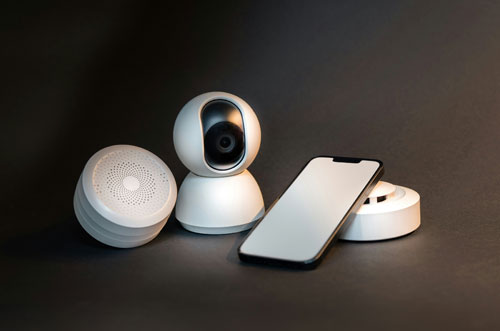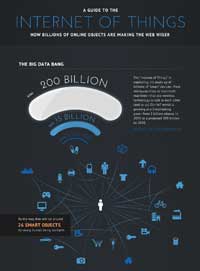IoT
The internet of things
What is IoT? | Privacy Concerns | Security Concerns
Technical Discussions
All trademarks, company names or logos are the property of their respective owners.

The Cloud and related content are contained in these pages:
- “Cloud” Computing
- Software as a Service (SaaS)
- Internet of Things (IoT)
What is The Internet of Things?
The “cloud” is only the beginning. The Internet of Things (IoT) is creating an environment where everything is connected.
The Internet of Things (IoT) refers to the increasingly numberous “connected devices” that you can control from your smartphone like Google Nest and Amazon Ring camera.
The Internet of Things is made up of a broad range of devices connected to the Internet including home thermostats, security systems, medical devices, refrigerators, televisions, smart televisions and toys. Our homes have become filled with these devices including Alexa and Siri. One device that people hardly give any thought to is your smoke detector. Newer, sophisticated smoke detectors have the capability to send data to your phone or the manufacturer which they do through your router and this makes them vulnerable to being hacked.
— Forbes
The future promises even more in the connected home such as a smart fridge that will order groceries for you when you're running low or window shades that rise or drop according to temperature or to create the illusion that you're home.
When many objects act in unison, they are known as having “ambient intelligence.” — Techopedia
Increasingly the Internet has more automated visitors (bots) that search for content, vulnerabilities and opportunities to influence outcomes.
Most website visitors aren't human. They're bots. Today, bots make up 52% of all web traffic. And these automated accounts have had serious, real world impact — from the 2016 [US] election, to the FCC's recent, controversial net neutrality vote.
— Mozilla Blog January 2018
Privacy Concerns
These small devices are not only communicating information but have access to information independent of what their owners and operators can see.
Smartphones can be tracked in real-time. Smart meters tell a great deal about your energy use (even when you're out). Imagine if everything about you is known in realtime.
Internet-connected appliances tempt people with science fictionlike conveniences, but beneath the sparkling surface lurk potential privacy violations.
— Ghostery
Security issues in IoT have gotten worse, not better, and it's time we acknowledge that and fix it. It's long past time.But that kind of development is hard to do, and it takes time and effort — and a lot of testing — to get right. You can read all of that as "expensive" and you wouldn't be wrong. Which is, quite possibly, why security has often been an afterthought. It's expensive.
— DZone
The regulatory and legal system can't keep up with the changes in technology.
Everything is Tracking Us
Even our kids' toys store information on an unsecured cloud server. Listen to the Mozilla IRL podcast or read the transcript to learn how little privacy we have left.
Car manufacturers will be able to monitor your every move with emotion-detecting AI and sell that data to insurers, advertisers and anyone else. Your car, once your safe environment away from home, is now revealing more about you than even your smartphone.
IoT is going to steal all your stuff. Well, not steal your stuff exactly, but quietly and invisibly shift ownership of some of your prized possessions to somebody else.
— DZone
It may be convenient to have your FitBit track your steps, heart rate and other health data, until that same data is purchased by your life insurance company. Your smart car allows you to connect your phone and provides realtime road data, but can also allow your car to be disabled remotely if your payments are late or if your driving is erratic.
A study of 314 IoT devices found that:
- 59% didn't adequately explain to customers how their personal data was collected, used and disclosed
- 68% failed to properly explain how information was stored
- 72% failed to explain how customers could delete their information off the device
- 38% failed to include easily located contact details should customers have privacy concerns
- 68% collected location data
- 64% asked for date of birth details
- 41% collected photo, video or audio files.
The only thing we can do is lobby to ensure that those that are in control of this information are held accountable in a public forum.
Who's Watching the Watchers?
If we've learned anything from the NSA spying scandal, it is that we cannot trust secret courts with secret rulings for oversight.
Security Concerns
Security is a concern with IoT devices. Manufacturers often have NO experience with connected devices or the need to secure them.
Cybercriminals hack into your devices that are a part of the Internet of Things to enable them to enlist your devices as a part of a botnet by which they can distribute malware while maintaining their anonymity. They also hack into your Internet of Things devices to access your home computers or cell phones to steal information for purposes of identity theft or to implant malware on your home computers and cell phones.The risks are extreme, but there are some basic steps you can take to protect yourself. The key to protecting yourself is having a secure router.
The devices that make up the Internet of Things also come with preset passwords that can easily be discovered by hackers. Change the password as soon as you set up any Internet of Things device. Also, set up a guest network on your router exclusively for your Internet of Things devices. This is important so that you can keep the sensitive personal information you have on your computer or cell phone from being accessible through a hacking of any of your Internet of Things devices.
— Forbes
“Smart” homes are dependent upon WiFi for their connections to the Internet. Too often IoT devices are hardwired with obsolete or marginal security protocols.
This environment now includes fridges, lighting, baby monitors, thermostats and more. Imagine coming home to a frozen house because someone remotely turned off the heat in the dead of winter.
LG has updated its software after security researchers spotted a flaw that allowed them to gain control of devices like refrigerators, ovens, dishwashers, and even access the live feed from a robot vacuum cleaner.
— ZDNET.
- FBI Warns about danger in The Internet Of Things.
- Security flaw in LG IoT software left home appliances vulnerable.
- Your WiFi-connected thermostat can take down the whole Internet. We need new regulations.
- Hacking Canon Pixma printers.
- The benefits and security risks of the Internet of Things.
- Secure or not, IoT is everywhere. Get used to it.
- Understanding security in IoT.
Many organizations such as hospitals are ill-prepared to deal with obsolete connected devices still in operation such as hard-wired yet Internet-connected Windows XP devices.
53% of internet-connected medical devices analyzed were found to have a known vulnerability, while one-third of bedside devices were identified to have a critical risk.
— ZDNET
DDoS by Compromised IoT Devices
An October 2016 a botnet made up of 100,000 compromised gadgets took down Netflix, Twitter and many others.
- Blame the IoT for destroying the Internet today.
- Lessons from the Dyn DDoS attack.
- Botnets of Things.
IoT Could Threaten Our Survival
We're building a world-size robot, and we don't even realize it.This world-size robot is actually more than the Internet of Things.
It'll also get much more dangerous.
The world-size robot we're building can only be managed responsibly if we start making real choices about the interconnected world we live in.
— Bruce Schneier
- IBM's Smarter Planet: the interconnection of the planet.
- Software updates are the new hurdle in IoT Security.
- Hurdles the Internet of Things must clear for manufacturers and providers.
- IoT devices lack standardization and cross-platform communication.
- The Internet of Useless Things: not everything is a breakthrough.
IoT's Potential Evolutionary Leap
If we can resolve the privacy, security and trust issues that both AI and the IoT present, we might make an evolutionary leap of historic proportions.
— Stephen Balkam
Technical Discussions
Intel's “A Guide to the Internet of Things” Infographic shows where we've come and where we're going with IoT.
The following are technical resources aimed at big businesses but will give you a clearer picture of who the players in the IoT game are.
- Microsoft on IoT.
- Microsoft's IoT white paper for business (PDF – 1.73 MB).
- IBM's The Economy of Things: Extracting new value from the Internet of Things.
- IBM's Internet of Things.
- Tapping M2M.
Related Resources
On this site:
- Resources index
- Artificial Intelligence (AI)
- “Cloud” computing
- SaaS: Software as a Service
- Mobile security
- Smart devices & privacy
Return to top
russharvey.bc.ca/resources/iot.html
Updated: June 14, 2025



